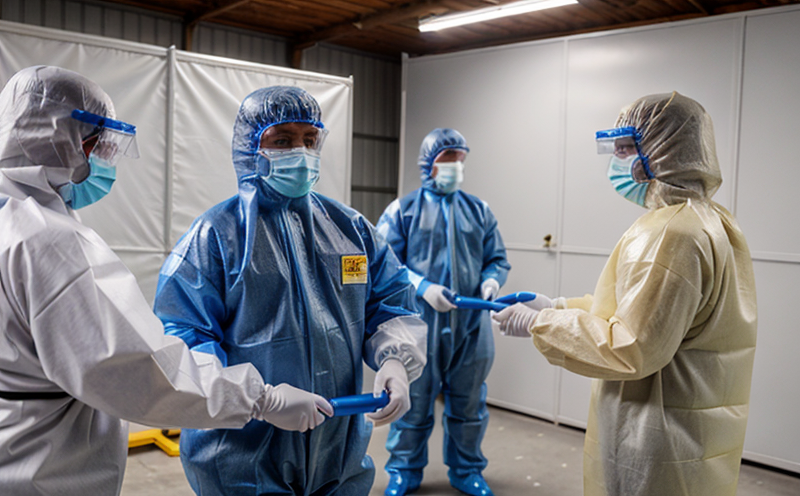EN 14605 Liquid chemical protective suits Type 3 and 4 testing
The European Standard EN 14605 sets forth comprehensive requirements for protective clothing designed to provide effective protection against liquid chemicals. This standard is particularly relevant for industries such as healthcare, emergency services, manufacturing, and laboratories where workers are exposed to hazardous substances.
Type 3 and Type 4 protective suits are specifically designed to protect against different levels of chemical hazards. Type 3 suits offer partial protection against liquids with limited risks, while Type 4 suits provide high protection against chemicals that pose significant health and safety risks. The testing process for these suits is meticulous and involves several stages aimed at ensuring the integrity and efficacy of the protective clothing.
The first step in the testing process is the selection of appropriate test samples based on the intended use of the suit. This includes determining the chemical resistance, breathability, and durability required by the end-user. After selecting the appropriate samples, they are subjected to various laboratory tests designed to simulate real-world conditions.
One of the critical tests involves exposing the suits to a range of chemicals under controlled conditions. The exposure time and concentration levels are carefully calibrated based on the chemical's hazard class as defined by the standard. During this test, the integrity of the suit is checked for any breaches or leaks that could compromise safety.
The physical properties of the protective clothing are also tested rigorously. This includes measuring the tensile strength, puncture resistance, and seam strength to ensure that the suit can withstand the rigors of use in demanding environments. Additionally, the breathability and comfort of the suit are assessed through specialized tests that simulate prolonged wear.
The testing process is not limited to mechanical properties alone; it also includes evaluating the suit's ability to maintain its protective integrity over time. This involves exposing the suits to high temperatures, UV light, and other environmental factors that could degrade the material. The durability of the suit in these conditions is crucial for ensuring long-term protection.
Once all tests are completed, detailed reports are generated summarizing the results of each test. These reports provide comprehensive data on the performance of the suits under various conditions and help manufacturers ensure compliance with EN 14605 standards. The quality assurance team reviews these reports to identify any areas where improvements can be made.
Customer impact is significant in this testing process, as it directly influences worker safety and satisfaction. By ensuring that protective clothing meets the highest standards of protection, workers are better equipped to handle hazardous situations with confidence. This leads to higher job satisfaction and reduced instances of workplace injuries or illnesses.
Enhanced safety for workers exposed to chemicals
Increased trust in protective equipment provided by manufacturers
Improved worker morale due to reliable protection
Reduced risk of chemical exposure leading to health issues
Elevated standards for industry compliance and reputation
Enhanced trust in the brand among end-users
The competitive advantage derived from this service is substantial. Compliance with EN 14605 not only ensures that protective clothing meets the highest safety standards but also provides a clear differentiator in the market. This allows manufacturers to command premium prices and build long-term relationships with satisfied customers.
Market impact is profound as well, with increased demand for high-quality protective suits leading to economic growth within the industry. It fosters innovation through continuous improvement of materials and designs aimed at better protection against chemical hazards. Furthermore, it sets a benchmark that other industries can follow in terms of worker safety protocols.





